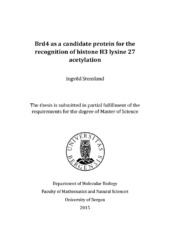| dc.description.abstract | Post-translational modifications (PTMs) of histone tails are associated with the regulation of transcriptional processes. Patterns of histone modifications mark regions of high or low transcriptional activity, and are recognized by reader proteins". The reader proteins are often transcription factors that recruit chromatin remodelling complexes or enzymes that add further modifications to histone tails. Genomic enhancer regions, responsible for cell- type specific activation of different genes, have been found to exhibit distinct patterns of histone modifications. Active enhancers are enriched in acetylation of histone H3 lysine 27 (H3K27ac), a mark which distinguishes active from poised and primed enhancers. In this work, we wished to find a protein which specifically recognizes this histone modification. Bromodomain- containing protein 4 (Brd4) is a transcriptional regulator that is known to be involved in the regulation of elongation by RNA polymerase II (Pol II). Brd4 has been shown to co-localize with H3K27ac at active enhancers, and was therefore chosen as a candidate for selective recognition of H3K27ac. Possible binding between the two bromodomains of Brd4 and H3K27ac was investigated by histone peptide binding assays, isothermal titration calorimetry (ITC) and surface plasmon resonance (SPR). Brd4 bromodomain constructs containing one or both bromodomains were engineered, and proteins were expressed and used in binding assays. Strong binding between Brd4 bromodomain 1 (BD1) and a H4 peptide acetylated at four lysines (H4tetra-ac) was observed, but in contrast to a previously published study, no binding between either of the Brd4 bromodomains to H3K27ac was detected in histone peptide binding assays and ITC. Possible reasons for these discrepancies are discussed and alternative functions for Brd4 and its bromodomains at enhancer and promoter regions are suggested. | en_US |
